This post will explain mechanical bicycle brake compatibility (i.e. brakes with cable actuation, not hydraulic) of both callipers and levers. Hydraulic brakes will be explained in a separate article. For an explanation of terms like the amount of lever cable pull and mechanical advantage, look at this article: Mechanical brakes – working principle.
Before you start, to avoid any misunderstanding:
please take the 5 minutes needed to read the compatibility articles use instructions.
1. Amount of cable pulled
For compatibility of mechanical brakes, it is important that the amount of cable pulled by the lever matches the required cable pull of brake callipers. If the lever pulls too much cable, the braking force will be very low. If the lever pulls too little cable, callipers won’t reach the braking surface.
For a detailed explanation look at the above already given link: Mechanical brakes – working principle.
Overview of compatibility will be given by brake lever types. Compatible brake callipers for each brake lever type. In chapter 4, there are pictures of each brake lever and calliper type, for easier identification.
2. Types of brake levers and callipers
These are the brake lever types with their amount of cable pull per full lever travel (about 20-degree angle):
- V-brake (also known as direct-pull, or linear-pull), 15 mm
- Cantilever (also known as centre-pull), 7 mm
- Old road, 7 mm
- New (SLR and Super SLR) road, 8 mm
Here’s a list of mechanical brake calliper types with their ideal amount of lever cable pull:
a) V-brake (also known as direct-pull, or linear-pull brakes), 15 mm
b) Mini V-brake, 7 mm (see chapter 5 for details)
c) Cantilever (also known as centre pull brakes), 7 mm
d) Old road callipers, 7 mm
e) New road callipers (SLR and Super SLR), 8 mm
f) MTB mechanical disc, 15 mm
g) Road mechanical disc, 8 mm
h) U-brake, 7 mm
i) Roller brake, 7 mm
Models that have not been produced for decades AND have become very uncommon have not been listed.
Road callipers are made as single (old version) and double pivot ones (both old and the newer version). In this post, the term “old road callipers” includes all the callipers that require 7 mm of cable pull, while “new road calliper” includes those that require 8 mm of cable pull. Most modern callipers are “new”. Shimano’s marketing term is SLR and Super SLR (even more cable pull, but just slightly, about 0.5 mm extra).
3. Compatibility of brake levers and callipers
3.1. V-brake (direct-pull, or linear-pull)
The lever pulls about 15 mm of cable. It is compatible with the following calliper types:
- V-brake (of course)
- MTB mechanical disc
3.2. Cantilever (centre-pull)
The lever pulls about 7 mm of cable and is compatible with:
- cantilever
- road mechanical disc
- new road callipers
- old road callipers
- mini V-brake (see chapter 5 for details)
- U-brake
- roller brake
3.3. Old road levers
They pull about 7 mm of cable and are compatible with:
- old road callipers
- mini V-brake (see chapter 5 for details)
- cantilever
- U-brake
- road mechanical disc
- roller brake
They can also work with new road callipers, but the pads would have to be set very close to the rim. This increases the chance of brakes rubbing the rim.
3.4. New road levers
Also called Shimano SLR, Shimano Super SLR (pulling even more cable) etc.
They pull about 8 mm of cable and are compatible with:
- new road callipers
- mini V-brake (see chapter 5 for details)
- cantilever
- U-brake
- road mechanical disc
- roller brake
They can also work with old road callipers, but the braking force will be slightly lower (due to a lower mechanical advantage).
4. Pictures of brake levers and callipers
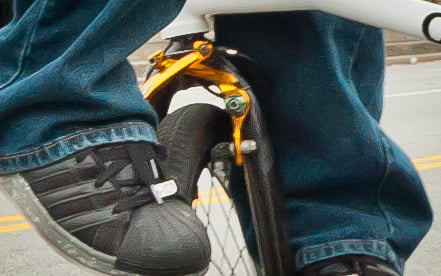
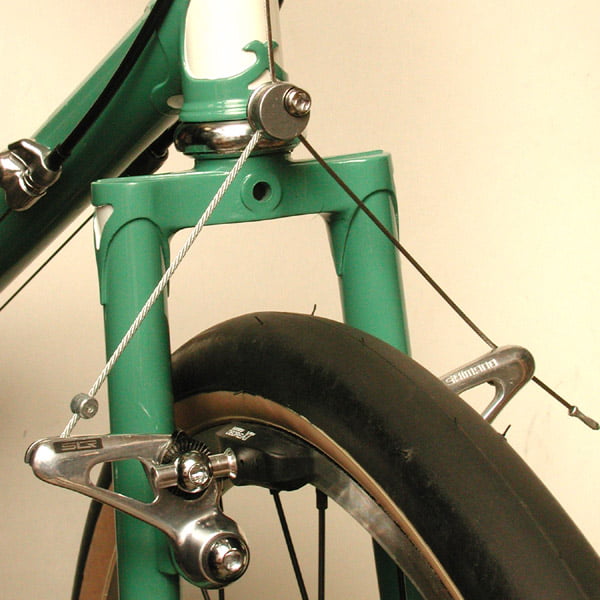
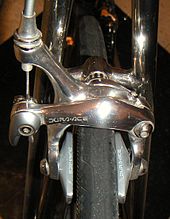
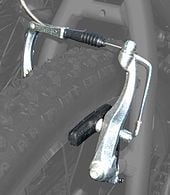
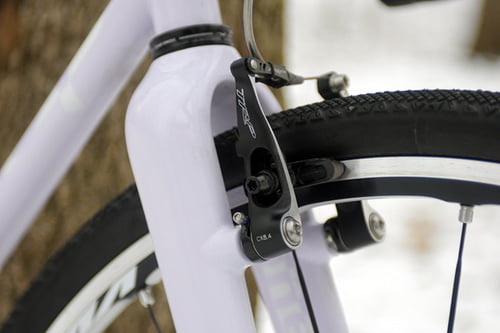
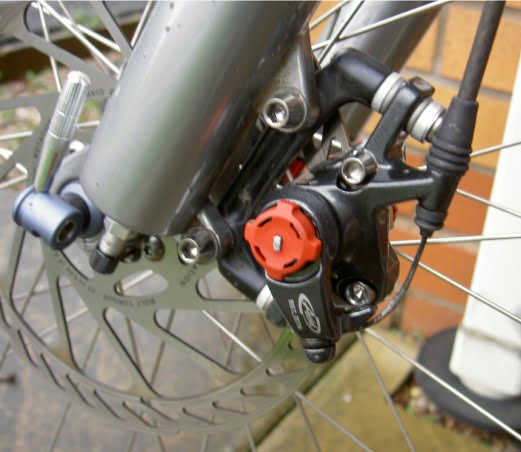
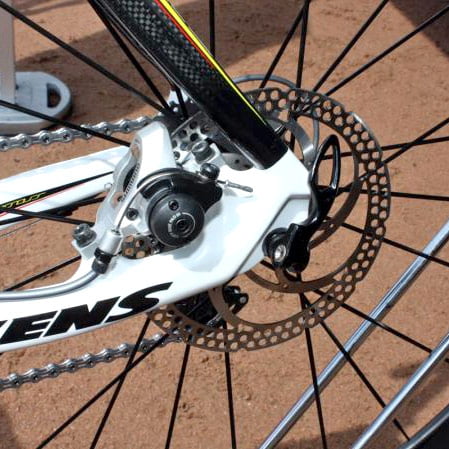
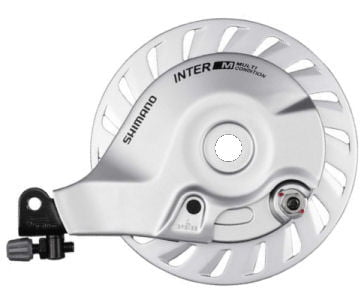
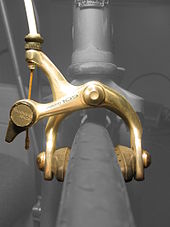
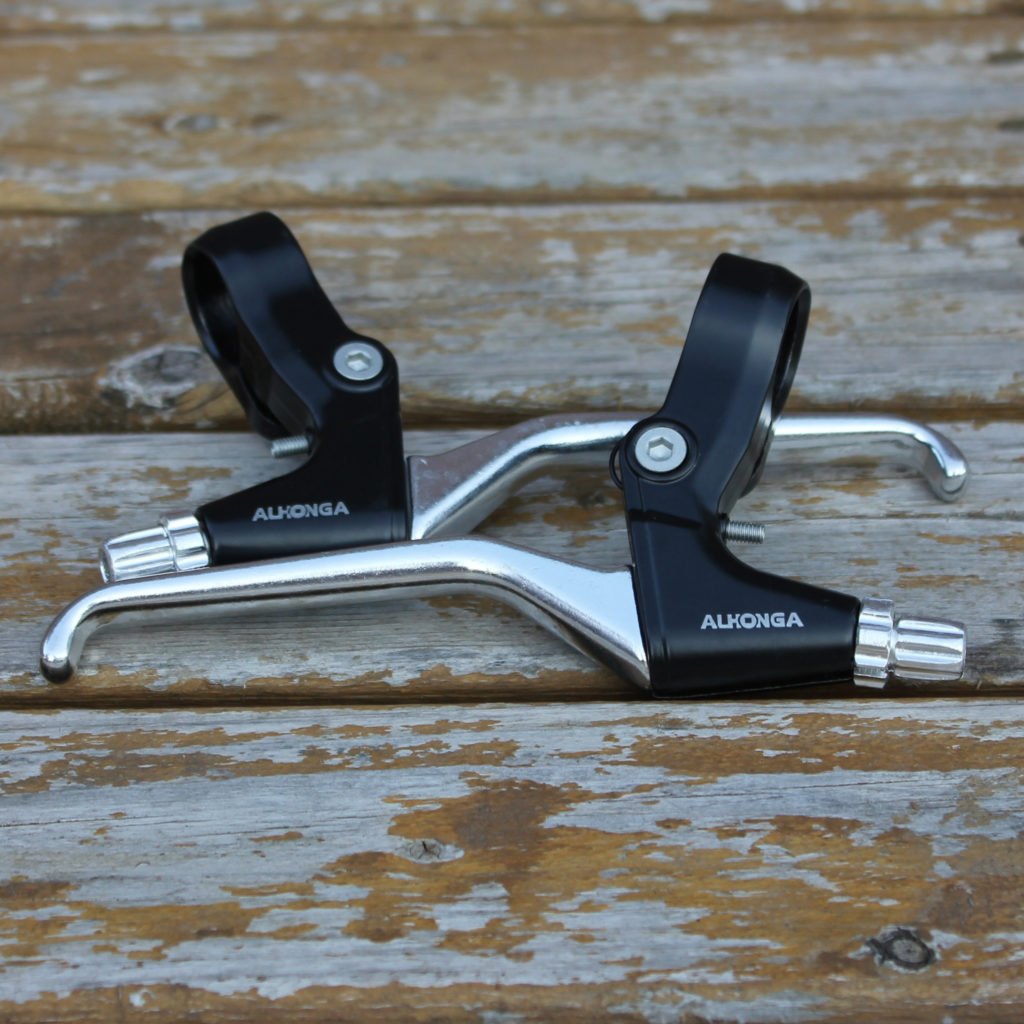
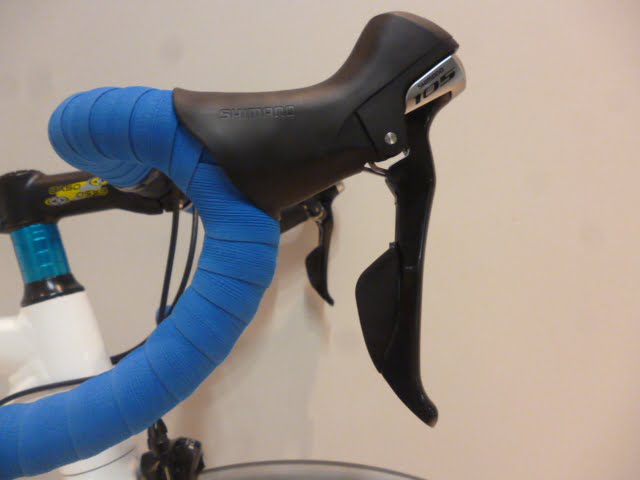
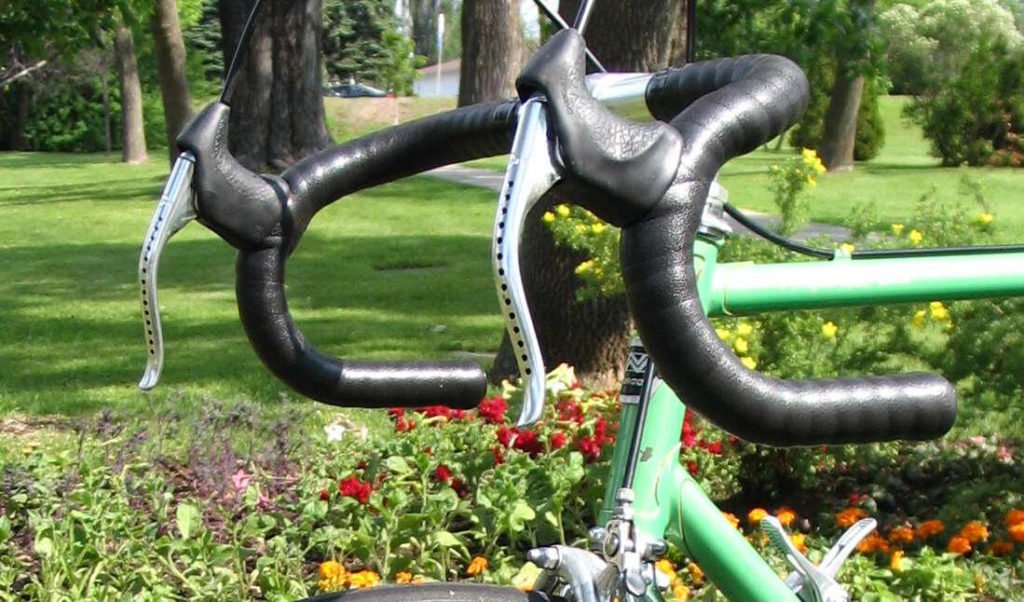
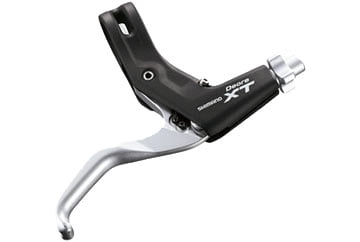
5. Mini V-brake caveats
As was nicely noticed and mentioned in Drew’s comment, some things were left unclear about the (mini) V-brakes. Not all the “Mini V-brakes” were created equal! Let me explain.
- “V-brake” is Shimano’s marketing term, the technical term for such brake design is “linear-pull brakes” (or “direct-pull brakes”).
- “Mini V-brake” is a jargon term for V-brakes with short(er) calliper arms. See the picture below:
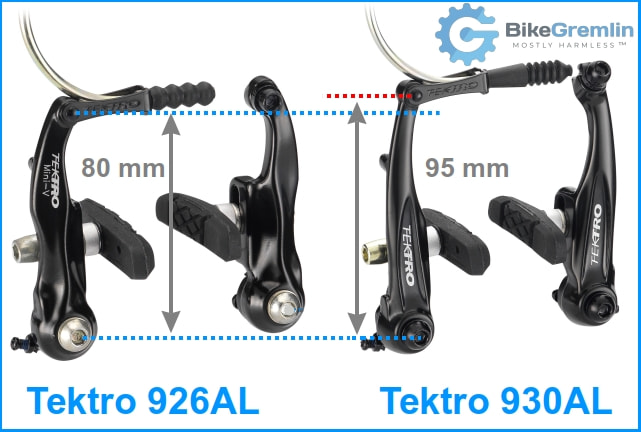
The above-depicted calliper arm length is what determines the optimal cable pull. The longer the brake arm, the more cable needs to be pulled by the brake lever.
What happens when these are not matched? Basically, you get poor braking. For more details, see the article called: “Mechanical bicycle brakes – working principle.”
Depending on the calliper arm length, V-brake (or linear-pull) callipers can be divided into three groups:
- Up to 80 mm – suitable for cantilever, and for old-style road brake levers.
- 85 to 90 mm – suitable for cantilever (but not perfectly), and for new road levers (Shiman SLR and similar).
- 95 mm and longer – suitable for V-brake levers.
6. Park Tool video demonstration
Park Tool has made an awesome video demonstration on this topic:
Compatibility posts are also available in eBook (printable and Kindle) and paperback editions on Amazon:
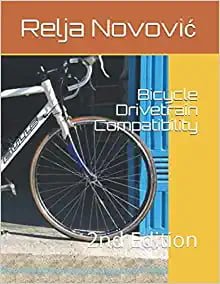
The existing comments posted under this article (questions and answers) have been moved to this BikeGremlin forum thread:
https://www.bikegremlin.net/threads/compatibility-08-mechanical-brakes-article-comments.118/
Last updated:
Originally published:

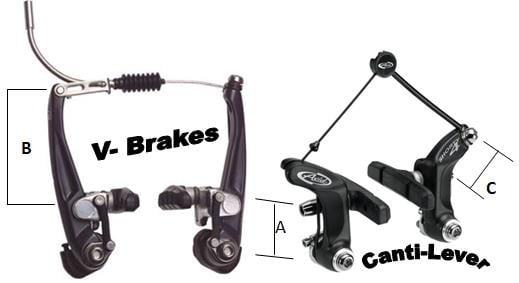
Hey, thanks a lot for this list. It is really helpful and it’s kindof the only one existing 🙂
I have one question:
Lets assume I have u-break calipers with a 7 mm pull and v break levers.
As the v break levers have a bigger pull than 7 mm, why are they ot compatible? Would the force be to strong?
Lever that pulls too much cable has lower mechanical advantage. So the brakes would feel nice and firm on a work stand, but have lower stopping power (for the same force used on the levers) compared to the same brake calipers combined with matching brake levers. The firm feel without a brake/stopping power test is dangerously deceptive.
Hi, why it is possible, that New road levers are not compatible with Old
road callipers and oposite, when
cantilevers are compatible with old and new levers?
Hi Marty,
Cantilever brakes can be adjusted for mechanical advantage to a certain degree. So the ~ 1 mm difference in levers’ cable pull can be compensated for with cantilever brake calipers.
Also, while the old road calipers will require a bit more hand strength with new road levers, they will not be too bad – unlike V-brakes, which require drastically more cable pull to work.
Relja
Would a Shimano Tourney 7 Speed Road Groupset brake lever be compatible with a MTB mechanical disc brake caliper?
Was under the impression that up to 10 (and more likely for 6, 7, and 8 speed) road & MTB parts are interchangeable.
Thanks in advance.
Regards
plevyadophy
Stated compatibility (up to 10 speeds) goes for shifters, not brake levers.
MTB and Road mechanical discs don’t have the same cable pull – MTB mechanical disc brakes require a lot more cable pull (such that only V-brake levers can provide). Pairing them with road levers (have done it) would require:
– Having very straight (true) discs
– So that pads can be placed as close to the disc as possible
And it would result in:
– Brake levers having a relatively long travel (in spite of pads placed very close to the discs, without that brake levers would bottom out before any strong brake force is achieved).
– Brakes having good modulation and very strong braking power, due to very large mechanical advantage caused by using road levers with a lot shorter cable pull than the calipers are designed for. But with the risk of levers bottoming out as soon as pads get any noticeable wear (requiring pads to be re-set to remain closer to the disc).
So I’d advise getting a pair of Avid BB7 ROAD brake calipers, if using road brake levers.
While Avid MTB BB5 and BB7 calipers are best used with MTB (V-brake) brake levers.
Hi,
Wow!! 😮
Thanks for the prompt and detailed answer.
As for brake calipers I am not a fan of Avid DB5./DB7 calipers.
I much prefer the TRP Spyke MTB Disc Caliper and Juin Tech hybrids (hydraulic caliper with mechanical pull).
Of the the TRP calipers I much prefer the design of the (weather proof) housing of the TRP Spyke (MTB) disc caliper over the TRP Spyre (Road) disc caliper, hence my original question.
Is there no adapter one can buy to alter the pull ratio of mtb and/or road brake levers?
Thanks in advance
P.S.
The reason I prefer TRP over Avid is that TRPs use a dual piston system just as hydraulic calipers do (that is, two opposing pistons moving at the same time)
Dual caliper action, especially if they work fine from your experience, is a technically better solution.
I’ve not had 1st hand experience with TRP, while Avids have served me well, for a relatively low price.
As for cable pull matching, Problem Solvers used to make “Travel Agent”. I can no longer see it on their website, found it on Wiggle, but it is also out of stock. At least a picture of what it looks like:
https://www.wiggle.co.uk/problem-solvers-travel-agent/
Hi, my bike has Shimano Deore LX cantilever levers. I would like to install a mechanical front disk brake. Would it be compatible? The brake levers and the sifters are together in one piece, so I prefer no to change it…
First the obvious (noting just in case): the frame (and the fork, of course) has to have disc brake caliper mounts for this to be possible.
For the question: road bicycle mechanical disc brake calipers use cable pull that is compatible with cantilever brake levers.
MTB disc brake calipers will not work very well (you’ll get too little brake pad travel, with huge mechanical advantage, so not very good braking force modulation).
Avid BB7 are quite good mechanical disc brake calipers, and they are made for road bicycles as well, example:
Avid BB7 Road disc brake calipers (Amazon affiliate link)
Hi. This may sound stupid but I’d like to clarify this.
I have a pair of V-brake levers. I’m planning to convert my rear from V-brake to mechanical disc brake (with adapter).
As I understand it, I can retain my lever to work the mechanical disc brake because they have the same cable pull. But I have to make sure that the disc caliper I install is one that is MTB-specific. Is this correct?
Exactly. 🙂
With V-brake levers, road bike mechanical disc brake calipers (such as Avid BB7 road) will feel very firm at the lever, but have poor stopping power even when strongest force at the lever is applied.
MTB mechanical disc brake calipers (such as Avid BB7, or BB5) will work properly.
What about mount compatibility, I have not found it in this article or elsewhere on your web. Are pivots for Cantilever, V and mini-V brakes the same so these can be used on single fork or are pivots different?
They all use the same pivots. I wrote a bit more about brake mounts in the article on bicycle forks:
Bicycle fork brake mount types – explained
Hi,
If I’m reading the compatibility correctly, for a road bike, if I have the ST-R7000 levers, or even ST-R8000 or ST-R9100 for that matter, for an 11 speed build, I should be able to swap out the rim brake calipers for mechanical disc brake calipers, if I’m cobbling together a Shimano groupset. Is that correct?
3.4. New road levers
Pull about 8 mm of cable and are compatible with:
new road calipers
mini V-brake
cantilever
U-brake
road mechanical disc
roller brake
Thank you!
Hello,
I’ll use Amazon affiliate links to show concrete models/products (and their prices).
It will work, with a note that road bicycle mechanical disc brake calipers should be used – such as Avid BB7 Road.
“Ordinary” mechanical disc brake calipers, such as Avid BB7, will not work with road bike STI-s, only with V-brake compatible levers.
There are some (exotic, rare) drop bar brake levers that are compatible with mechanical MTB disc brake calipers (and V-brakes for that matter), such as Tektro RL520, but I don’t know of any model with a shifter mechanism integrated (as in STI-s).
So make sure to use disc brake calipers designated for “road” bicycles. Otherwise, those Shimano STI-s won’t be pulling nearly enough cable to work properly.
Thank you so much for the information. Extremely helpful!
Fred
Really big thanks mate from Australia on posting technical information on aspects of the Bicycle.Have moved away from Bicycle Shops working on my bicycles to myself doing all repairs which gives me great satisfaction.
It’s a bit Zen-like, isn’t it? 🙂
Shouldn’t the list labeled 3.1 V-Brake also read “Linear Pull” and not “Direct Pull”? And then 3.2 Cantilever be labeled “Direct Pull”?
In section 4 the picture also says Direct Pull and Cantilever.
Hi Jason,
Thanks for the heads up.
I’ve corrected the article.
V-brake is Shimano’s term that is now most widely used, though the brakes are linear-pull or direct-pull.
Cantilevers are center-pull.
Relja
I’ve been cobbling together an all-around bike based on an old 2010 era cyclocross frame designed for Cantilever brakes and Road shifters. I currently have it set up as a flatbar with Sora Road shifters/derailleurs (3×9) and Alivio MTB V-brake levers/calipers. I recently acquired older Sora brifters with a 21mm pull radius for the brakes, and I’d like to convert it back to a dropbar bike, but not use Cantis if I can avoid them. The frame has no option for anything other than Cantis or V-brakes.
I am aware that I can purchase travel agents to solve the pull ratio problem and keep my current V-brake calipers, but I’d like to avoid the extra “mechanics” in the system. You stated that Mini-Vs, Cantis and old road calipers all have the same 7mm cable pull. I can get either option for almost the same price. That leaves me with three questions.
What length are the calipers on the Mini Vs you are referencing? I am aware that Shimano makes a 9mm (BR-R353) and Tektro has them at 8mm (926AL) for BMX bikes (which are lower cost)
Using 9mm and 8mm as the comparison, which one of those offers more braking power for the same hand force pulling on the lever?
If 9mm gives more braking power (my assumption), would the main reason for going with 8mm be that the brake lever would need to pulled less distance to achieve initial brakepad contact, allowing for less tight tolerances in the brake system setup?
Any other insight you can offer would be appreciated as well. Thanks.
Hi Ron,
Short answer:
I’d get the Tektros and be done with it. 🙂
A longer answer with due explanations:
Mini V-brakes generally come with 80 to 85 mm long arms.
90 mm long ones are borderline-compatible in my opinion (you get more mechanical advantage, but also more lever travel).
“Standard” (“MTB”) V-brakes usually have 100 mm or longer arms (often 110 mm or even longer).
Manufacturers often state compatibility (and/or label the brakes as “Mini V-brakes”) – road bike levers, or flat bar levers.
To answer the “what’s better” question – I’ve explained the working principle and the mechanical advantage in this article:
Mechanical bicycle brakes – working principle
So it boils down to the mechanical advantage, with a few more notes:
If there’s not a huge mismatch in cable pull and if one’s hands aren’t very weak, the weakest link in terms of braking power is the tyre traction, not the power of brakes.
At least with decent quality cables, housing, levers, brake callipers, brake pads and aluminium rims (steel rims are very bad for braking in the rain).
I prefer to not have a huge amount of lever travel, so I’d go with the 80, or 85 mm long brake arms.
On the other hand (pun intended 🙂 ), for braking a lot from the hoods (when one is using the smallest few fingers to actuate the levers), I suppose longer brake arms would help by providing a greater mechanical advantage. Longer lever travel this setup will result in will also help by allowing for a stronger grip from the hoods (when the levers are closer to the bars, having travelled more). The downside of such a setup is that pads would have to be quite close to the rim, in order to prevent the levers from hitting the bars when braking hard from the drops (when one can apply a lot more force to the levers).
I agree that using extra stuff like travel agents only makes things heavier, more complicated, less rigid and I too prefer avoiding all that. 🙂
Great article. Thanks so much. Let’s see how I go putting new brakes on an old steel frame I just picked up…
*edited version for clarity, please delete first comment*
I wouldn’t list mini v brakes as 7mm. For one, a TRP CX 9.0 would be compatible with Shimano SLR stuff which would make it “8mm” by your system. The TRP CX 8.4 which is 84mm long would then be 7mm as per your system but then what over the 80mm mini v brakes out there? The fact that there’s an 80mm to 95mm range alone makes that an inaccurate statement regarding “mini v” brakes, labeled as such. It’s a spectrum, not a brake type.
I use TRP for an example because that’s the first mini-v that was explicitly marketed for use with a short pull lever. But if you look up various Tektro mini-v brake calipers on the Tektro website they explicitly list them as linear pull. This holds true for the 80mm 926AL which is supposed to be used with the linear pull levers 313A or 316AG and it also holds true for the 85mm BX3V with the same levers. Those same levers are also recommended for a couple of 95mm calipers (BX25 and 930AL). Both levers clearly state “for use with linear pull brakes.”
Any Tektro brake that is recommended to be paired with 316AG is linear pull. The short pull lever is 316AC. If Tektro wanted the above to be clearly categorized as “short pull” they wouldn’t call them linear pull and they wouldn’t suggest using 316AG rather than 316AC (which they explicitly do recommend for caliper or U-brakes, on the same page).
So while mini-v’s have short enough arms to work acceptably with a “short pull” system (and often marketed as such), they are really designed for linear/long pull systems… or at the very least, they are somewhere in between. The fact that you need to run them so close to the rim with short pull levers is also evidence that this is not the design purpose so they are definitely NOT designed with 7mm of pull in mind (they work, but just barely). I think you should change “7mm” to a footnote and not assign a value due to the unfortunate ambiguity (or measure the cable pull of a 316AG specifically and record that as the actual measured value, rather than speculating it by pinning it to road pull, as you’ve presumably done).
Granted, there is ambiguity. The CX specific 90mm RX6 shows compatibility with road/short pull levers while the 85mm RX1 is listed as “linear pull” with no recommended lever listed; I believe this is marketing rather than engineering doing the speaking here. Some of the 110mm length v-brakes are recommended to be paired with CL-530 (also listed as linear, but notable that a different lever is recommended with the 110mm vs the 80-95mm as above). So my objection is mostly due to not noting any ambiguity, rather than assigning a hard number to mini v brakes… but it’s both, considering all the issues I’ve laid out here.
As always, thank you for this site and all the hard work!
One other follow up.. see https://tektro.com/upload/Product/F_20210302182682aZqjUD.PDF
Both standard v-brakes and mini-v brakes are categorized as linear pull brakes in the installation instructions and Tektro explicitly states to use linear pull brake levers with both.
Hi Drew,
Thank you for the comment – some very good notes and I’ll make sure to update the article and elaborate a bit more.
Edit:
I’ve updated the article, adding a whole “chapter” on (Mini) V-brakes.
One caveat though:
“Linear-pull” in and of itself doesn’t dictate the optimal cable pull for the brake. It only describes how the cable is routed, attached and, of course, pulled.
As far as I know, “V-brake” is a Shimano trademarked name, while “linear-pull” is a general, technical term.
In my experience, V-brakes (i.e. linear-pull brakes) with arms that are up to 80 mm long, work well with the old, classic road bike (drop bar) brake levers.
While V-brakes with brake arms that are 100+ mm long work well with the flat bar V-brake levers.
85 to 90 mm long ones are best suited for the Shimano Super-duper-mega-giga SLR, i.e. the modern Shimano road bike indexed shifter&brake levers (i.e. STI).
Again,thank you very much for taking the time to read and comment. I had completely forgotten to update this article, in spite of having played a lot (and recorded a few videos) with a few different mini V-brake models this Spring. This is not the first and, hopefully, not the last mistake I’ve made – and one of the reasons for publishing articles and videos is such great feedback that also helps me learn and correct mistakes (in addition to sharing knowledge and info, which is rewarding).
Given that there has been more discussion and that I now have my own experience, I thought I might follow up on my previous questions.
I did install the Tektro 926AL Mini-V brakes (80mm center to center calipers) for use with my older Sora road brifters. I also replaced the most likely very old brake pads with longer MTB style pads, and I think that was actually important. There is no question that the mechanical advantage of this setup is high. I can lock up the brakes with ease. But yes, I have to keep the clearance between the pads and rim to a closer tolerance than I would with my MTB V-brake levers. With an external rim width of 21mm and a tire size of 700x28c, I must loosen the cable length adjuster in order to open the calipers for tire removal. Cutting a bit of length off the tip of the noodle would help a bit, but larger tires would create more of a problem.
So my personal general conclusion is that this is a workable and reasonable solution if one takes into account all of the variables (including rim and wheel size) and makes the necessary adjustments.
On an aside, years ago I bought a set of Tektro MT3.0 flatbar brake levers, not knowing what they really were. They can be set up with a pull radius of 30mm or 37mm (self measured), which is not what I had expected. But this just points out that there are a wide range of possibilities in any bike braking system, and this site is a great resource for those of us trying to work out something that is “non-standard”.
Thanks!
Hi Ron,
Thanks for the feedback – it pretty much aligns with my own experience using the 926AL. 🙂
This spring, I built myself what’s now called a “gravel bike” – with a relaxed geometry, higher handlebars, longer chainstays, and clearance for wider tyres to take through the muddy autumn.
If anyone’s interested, here’s some talk about the frame I used (YouTube link).
Installed Tektro 926AL Mini-Vs, and they did require installing an inline barrel adjuster, to allow the brake’s quick-release to work, without the pads being too far away from the rim for the brake to work normally (without the levers bottoming out). That’s with the old-style levers (not the modern, a bit longer-pull SLR & Super SLR STIs).
As you said: a bit greater mechanical advantage. Sure, that allows me to brake hard even from the hoods, but I’d prefer a bit more brake-to-rim clearance, even with a lower mechanical advantages (hands still strong enough). Having said that, with the brake’s quick-release “activated,” I can remove and mount a 35 mm wide tyre with no problems (Continental Double Fighter).
MTB V-brakes, with their longer brake arms and a lot more cable pull, are less sensitive to any cable, housing and fork legs flexing – it doesn’t affect the brake “squishiness” nearly as much. So my preferred option would be to use drop bar brake levers with a MTB V-brake cable pull (Tektro makes some, like Tektro RL520 – Amazon affiliate link).
However, I ride the bike on flats and hills, on and off road, had more than a few cars pull up without looking (as usual), even during a downhill ride, and I find the brake performance to be good. Hell, I’ve got some decent-quality cantilever brakes in the garage, and I’m not mounting them – quite satisfied with the current setup. I’d call it good. Not excellent (prefer more clearance), but good. 🙂
Campagnolo isn’t mentioned much in this article. If I wanted to upgrade a road bike that has a 10-speed Shimano 105 group to Campagnolo shifting, could I keep the 105 calipers and operate them safely with Campagnolo 11-speed or 12-speed ergopower shifters?
Hi Joachim,
As far as I know, Campagnolo have also altered their cable pull across brake/lever generations.
However, it is not enough of a change to render brakes unsafe – boils down to getting a bit more/less mechanical advantage (and a bit less/more brake pad travel per mm of cable movement).
So I would expect the combination to work OK.
It’s also worth noting that the old Shimano road 10-speed standard (like the 10-speed 105) offers by far the worst shifting experience (to little cable pull per shift, with tightly packed cassette sprockets). Going a few tiers lower to Shimano Claris (8-speed) can result in crispier shifting, with less frequent need to tune anything. The same goes for the new, Tiagra 4700 10-speed shifters and derailleurs. That may offer a lot better bang for the buck (without sacrificing shifting quality) compared to going with Campagnolo (unless Campagnolo is not much more expensive in your country, and if it is easily available).
Thank you for the quick reply. My thinking with the shifting upgrade to more sprockets was to take advantage of the extra sprocket (or two) to add lower gear(s) while still keeping small jumps between gears for optimum cadence. On long steep climbs I’ve been struggling, and I’m not getting younger. The switch to Campy would be for sentimental reasons, have always been dreaming of a bike with Italian groupo. 😉
Campy parts are more expensive, which is why I’m looking to keep some of the existing pieces like brake calipers, and possibly cranks, which can make a difference, with the downside of ending up with a weird mix of parts on the bike.
Hi, excellent info. I have a basic question, I want to convert my road bike with SRAM Rival brakes and levers, to a flat bar bike. I’d like to keep the Rival calipers but what levers should I buy, I thought these would work, but reading this site I suspect they pull too much and would not work
https://www.pushys.com.au/avid-08-a-speed-dial-7-brake-lever-graphite-pair.html
Hi Ray,
The page (site) you linked to doesn’t let me visit it (it probably prevents people from my country from visiting, a very poor website-security policy resorted to by incompetent webmasters – sorry about the digression, but it is frustrating).
Flat bar brake levers that work with road bike callipers are the following:
– Cantilever brake levers (often available used / 2nd hand)
– Special road calliper compatible flat bar levers, such as Shimano Ultegra BL-R780, Tiagra BL-4700, Sora BL-R3000, Claris BL-R2000 etc – Amazon affiliate links (these are also cantilever-compatible, just sold/marketed for a different use-case).
Shimano used to make flat-bar levers with an adjustable cable-pull ratio, so one can choose to configure them either for V-brakes, or for cantilever/road callipers. I have such (decades old) levers on my commuter. I’m not sure if the above-listed models have that option (Shimano claims they are also V-brake compatible, but I don’t see a way to adjust the cable attachment position for making them pull more cable).
Thank you, I appreciate your response.
Hi, how much cable is pulled by SRAM Force cable brake levers? Your guide only mentions Shimano standards. I want to know if they are compatible with TRP Hy/Rd calipers. I have installed them but I can pull the levers all the way to the bar and they still don’t engage properly.
I haven’t tried that model so I don’t know. Manufacturer swears they are “functional with all existing lever and shifter/lever combinations.”
TRP HY/RD are hydraulic calipers actuated via cable – so they aren’t really mechanical brakes. If the calipers don’t go out sufficiently (and remain so) after several pumps of the lever, I would start looking at their adjustment options:
They have a barrel adjuster to remove any cable slack (similar to how mechanical disc brakes work). Before doing that, i.e. before threading the cable in, according to the TRP HY/RD user manual, you should push and thread in the lever arm lock nob (I don’t know if that affects the brake caliper’s travel in a way to achieve the optimal lever pull brake actuation/pad disc contact point).
If you’ve installed and configured it properly, and cable slack removal using the barrel adjuster doesn’t help (i.e. the brakes still bite only when the levers are all the way to the bars), I’d check the level of brake fluid in the calipers.
Relja
Hello Relja,
Great article I didn’t even hope to find online. I wanted to add on my cheap second hand steel frame racing bike double pivot calipers, but had the suspect something wasn’t going to work as I hoped, as the levers seemed to have a much longer pull than my previous racing bike with 9 speed indexed Campagnolo gears and brakes.
And I was indeed right.
Well, my down-to-earth thought: if newer calipers need less pull, can I simply modify the levers drilling holes for the part that hold the cable end? Making these holes a tad closer to the fulcrum of the brake lever?
Yes, the ideal should be to buy levers and brakes together, but then I would also like indexed gear and I ain’t gonna buy two sets of levers… indexed gears need also a new transmission set, likely cranks, chainrings, changing the 6 speed freewheel to indexed gears means a different hub which will be wider too, so I will need to cold set the steel frame to accommodate a more modern wheel. And all this seems a bit excessive, all in one go, considering that for now I just want to have more braking power and better pads.
So, do you think that my plan to change the pull action of the brake levers would work? They are bent-to-shape alloy Sulky levers, with a transversal cable retainer that is held in place as it has a pin each side that go into two concentric holes each side of the lever.
Picture to show how they look like:
https://scontent.fmad17-1.fna.fbcdn.net/v/t39.30808-6/345322475_963864481465483_4852641663135267481_n.jpg
I want to drill a hole above where it is now, closer to the fulcrum of the lever.
Thanks in advance,
Luca
Hi Luca,
If your calipers need less cable pull than your levers provide, then sure, technically, reducing the pivot point’s “lever” length (by making the cable attachment be closer to the pivot) will reduce the amount of levers’ cable pull.
My commuter bike (with flat bars) has levers with an adjustable pivot point. Here’s the picture (I could not open your picture from the link):
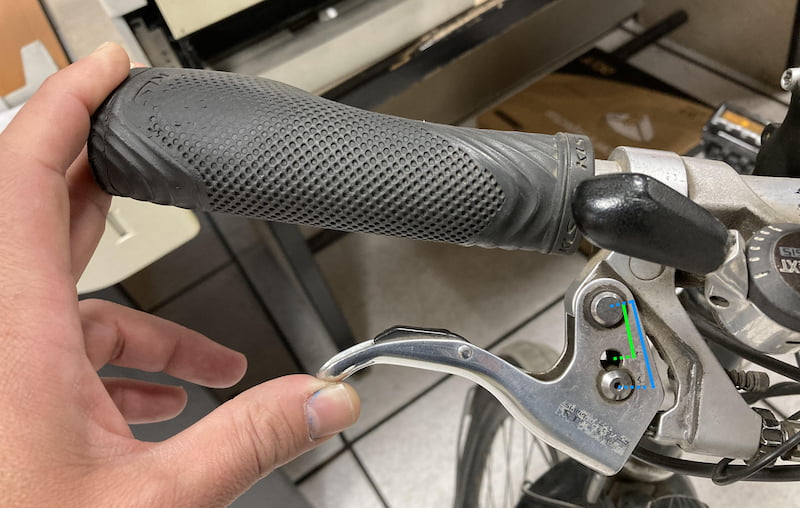
Now, if you drill the levers, my main concern is whether their strength/integrity might be compromised. Brakes are a critical safety component. I suppose you could give it a go, test it with some hard pulls, and then keep an eye on it, see if there are any cracks emerging.
Also, make sure whether you need more or less cable pull. If memory serves me well, modern road calipers require a bit more cable pull compared to the old ones.
Relja
Hi Relja,
Thanks for your reply, I tried to link it up but the URL expired, how do you embed pictures like that? This time it should work: https://ibb.co/gm5ZMCB
Anyway, perhaps again I will just start collecting parts until I have for example e set of levers and brakes, and doesn’t matter if they are with indexed shifters built in; I will abandon the down tube ones once I will have proper derailleurs and a compatible rear wheel
Hi Luca,
This time the picture loaded fine. Thank you. 🙂
That kind of levers might work OK with modern road brake calipers – they are definitely worth giving it a try at least to see if it’s good enough.
I’m a big fan of down tube shifters, especially those that can work in friction mode – they are indestructible. 🙂
P.S.
Regarding images:
The site lets me add and edit HTML as I like, while that is not allowed for visitors commenting (for spam prevention and security reasons – there are just too many abuse attempts on a daily, even hourly basis). I see you’ve figured it out, but if it helps anyone else, I wrote a tutorial that works for the site, and for bikeforums.net: 🙂
How can I add images to a comment?
Will try to add a link to that tutorial near the comment box.
Relja
Thanks Relja,
Yes, these are friction and work well, but I also like the precision and the smoothness of modern indexed gears, especially if it is a system I assembled and adjusted myself.
And I’d honestly like a 1× system on this bike but I have to study them well (chain widths, chain line and things, to see what I can mix and match). Of them, I am not keen on the mountain bike-like chain ring at the front: when I had my last bike, a Raleigh frame I built as single speed with parts bin components, I reused the cranks of my previous racing bike, single ring, and it had a 52/14 ratio 😄
https://ibb.co/rfjtDKx
Sorry for the mock up artisanal lenticular wheel, on my bike I will soon make it nicer and lighter! 😄
Hey Relja,
This has been a most interesting and informative read! I’m looking at some Campagnolo Veloce flat bar shifters/brakes and would like to use them with cantilever brakes. The model I have an opportunity to buy (just like these: https://www.probikekit.com/bicycle-gear-levers-shifters/campagnolo-veloce-flat-bar-bicycle-shifters-10-speed/10771984.html) say that they only work with “dura-pivot or differential Campagnolo caliper brakes”, which I assume is either pulling 7 or 8mm of cable, and ought to work fine with my canti brakes? Does that sound right to you? Thanks so much for your help!
Best,
Blake